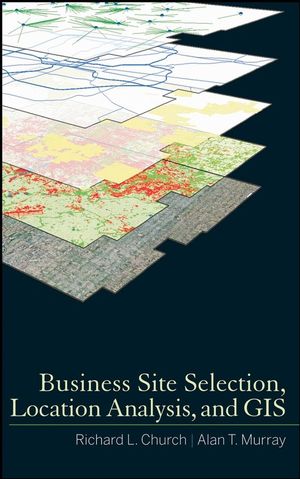Business Site Selection, Location Analysis and GISISBN: 978-0-470-19106-4
Hardcover
320 pages
October 2008
 This is a Print-on-Demand title. It will be printed specifically to fill your order. Please allow an additional 10-15 days delivery time. The book is not returnable.
|
||||||
Preface & Acknowledgment.
Chapter 1: Introduction.
1.0. Motivation.
1.1. History.
1.2. First Principles.
1.3. Planning context.
1.4. Role of GIS.
1.5. Summary.
1.6. Terms.
1.7. References.
1.8. Exercises.
Chapter 2: GIS.
2.0 Introduction.
2.1 Data Acquisition.
2.1.1 Existing sources.
2.1.2 Semi-existing sources.
2.1.3 Surveying and airborne approaches.
2.2 Data Management.
2.2.1 Raster.
2.2.2 Vector.
2.3 Data Manipulation.
2.3.1 Conversion.
2.3.2 Aggregation.
2.3.3 Overlay.
2.3.4 Interpolation.
2.4 Data Analysis.
2.4.1 Query.
2.4.2 Proximity.
2.4.3 Centrality.
2.4.4 Service zone.
2.5 Data Display.
2.6 Summary.
2.7 Terms.
2.8 References.
2.9 Exercises.
Chapter 3: Model Building Fundamentals.
3.0 Introduction.
3.1 Review of Mathematical Notation.
3.1.1 Variables.
3.1.2 Mathematical expressions.
3.1.3 Inequalities.
3.2 Formulating an Optimization Model.
3.2.1 Apple shipment.
3.2.2 Manufacturing plant location.
3.2.3 School consolidation.
3.3 Model solution.
3.3.1 Apple shipment application.
3.3.2 Manufacturing plant location application.
3.3.3 School consolidation application.
3.4 Summary.
3.5 Terms.
3.6 References.
3.7 Exercises.
Chapter 4: Trade and Service Areas.
4.0 Introduction.
4.1 Problem Definition and Motivation.
4.1.1 Descriptive trade area.
4.1.2 Prescriptive service area.
4.2 Mathematical Representation.
4.2.1 Descriptive trade area.
4.2.2 Prescriptive service area.
4.3 GIScience.
4.4 Modeling Application.
4.4.1 Descriptive trade area.
4.4.2 Prescriptive service area.
4.5 Advanced Topics.
4.5.1 Spatial interaction considerations.
4.5.2 Transportation problem considerations.
4.5.3 Using trade and service area models in site selection.
4.6 Summary.
4.7 Terms and Concepts.
4.8 References.
4.9 Exercises.
Chapter 5: Suitability Analysis.
5.0 Introduction.
5.1 Problem Definition and Motivation.
5.2 Suitability Assessment Process.
5.2.1 Absolute suitability.
5.2.2 Relative suitability.
5.3 GIScience.
5.3.1 Map algebra.
5.3.2 Attribute data measurement.
5.4 Model Application.
5.4.1 Absolute suitability.
5.4.2 Relative suitability.
5.5 Advanced Topics .
5.6 Summary.
5.7 Terms and Concepts.
5.8 References.
5.9 Exercises.
Chapter 6: Point-Based Location .
6.0 Introduction.
6.1 Problem Definition and Motivation.
6.2 Mathematical Representation.
6.2.1 Formulating the Weber problem.
6.2.2 Iterative solution approach for the Weber problem.
6.3 GIScience.
6.3.1 Projections and coordinate systems.
6.3.2 Spherical distance.
6.3.3 Planar distance.
6.4 Modeling Application.
6.4.1 Solution using commercial software.
6.4.2 Iterative solution.
6.5 Advanced Topics.
6.5.1 Variants of planar single facility location.
6.5.2 Fallacy of the centroid .
6.5.3 Location on a sphere.
6.5.4 Continuously distributed demand.
6.6 Summary .
6.7 Terms and Concepts.
6.8 References.
6.9 Exercises.
Chapter 7: Line-Based Location.
7.0 Introduction.
7.1 Motivation and Problem Definition.
7.2 Mathematical Representation.
7.2.1 Shortest path model.
7.2.3 Exact solution approach.
7.3 GIScience.
7.3.1 Defining the network.
7.4 Modeling Application.
7.4.1 Path.
7.4.2 Corridor siting in ArcGIS.
7.5 Advanced Topics.
7.5.1 Expanding the network.
7.5.2 Shortest path variants.
7.6 Summary.
7.7 Terms and Concepts.
7.8 References.
7.9 Exercises.
Chapter 8: Area-Based Location.
8.0 Introduction.
8.1 Problem Definition and Motivation.
8.2 Mathematical Representation.
8.2.1 Knapsack model.
8.2.2 Threshold model.
8.2.3 Shape model.
8.3 GIScience.
8.4 Modeling Application.
8.4.1 Knapsack model application.
8.4.2 Threshold model application.
8.4.3 Shape model application.
8.5 Advanced Topics.
8.6 Summary.
8.7 Terms.
8.8 References.
8.9 Exercises.
Chapter 9: Coverage.
9.0 Introduction.
9.1 Problem Definition and Motivation.
9.1.1 Complete coverage.
9.1.2 Maximal coverage.
9.2 Mathematical Representation.
9.2.1 Complete coverage.
9.2.2 Maximal coverage.
9.3 GIScience.
9.4 Modeling Application.
9.4.1 LSCP.
9.4.2 MCLP.
9.5 Advanced topics.
9.5.1 Backup coverage.
9.5.2 Service availability.
9.5.3 Spatial representation.
9.6 Summary.
9.7 Terms and concepts.
9.8 References.
9.9 Exercises.
Chapter 10: Dispersion.
10.0 Introduction.
10.1 Problem Definition and Motivation.
10.2 Mathematical Representation.
10.2.1 Neighborhood restrictions.
10.2.2 Pairwise restrictions.
10.2.3 Clique restrictions.
10.3 GIScience.
10.4 Modeling Application.
10.4.1 Neighborhood restrictions.
10.4.2 Pairwise restrictions.
10.4.3 Clique restrictions.
10.5 Advanced Topics.
10.5.1 Hybrid restrictions.
10.5.2 Max-min-min dispersion.
10.6 Summary.
10.7 Terms and concepts.
10.8 References.
10.9 Exercises.
Chapter 11: Location-Allocation.
11.0 Introduction.
11.1 Problem Definition and Motivation.
11.2 Mathematical Representation.
11.2.1 Heuristic solution.
11.3 GIScience.
11.4 Modeling Application.
11.5 Advanced Topics.
11.5.1 Continuous space siting.
11.5.2 Service capacities and fixed costs.
11.5.3 Accounting for uncertainty and error.
11.6 Summary.
11.7 Terms and Concepts.
11.8 References .
11.9 Exercises.
Chapter 12: Conclusion.
12.0 Introduction.
12.1 Classes of Location Models.
12.2 Class Variety and Extensions.
12.3 Solution Approaches.
12.4 Final Thoughts.
12.5 References.
Glossary.
Index.



